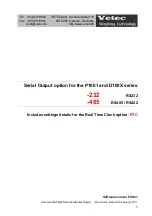
55
K-Cube Position Aligner
Low Pass Filter
- The output of the derivative (differential) part of the PID controller
can be passed through a tuneable low pass filter. Whilst the derivative component of
the PID loop often improves stability (as it acts as a re taining force against abrupt
changes in the system), it is prone to amplifying noise present in the system, as the
derivative component is sensitive to changes between adjacent samples. To reduce
this effect, a low p ass filter can be applied to the samples. As noise often tends to
contain predominantly high frequency components, the low pass filter can
significantly decrease their contribution, often without diminishing the beneficial,
stabilizing effect of the derivative action. In some applications enabling this filter can
improve the overall closed loop performance.
Click the Enable checkbox to enable the filter.
The
Cut Off Frequency
is specified in Hz in the range 0 to 10000.
Output Limit Settings
- These parameters are a pplicable only when operating in
closed loop mode. The XOut and YOut values are the low voltage signals sent to the
X DIFF and Y DIFF connectors, which are then used by the piezo K-Cubes to drive
the piezo mirror in order to keep the beam central in the detector. (See the next topic
for a typical application.
Under normal operating conditions, these values are between -10 V a nd +10 V
however, some applications may require the limits to be less than this. The
Output
Limits
can be used to set the limits for the XOut and YOut values, between -10V and
+10V.
Feedback Gain Settings
- These parameters are applicable only when operating in
closed loop mode, and set the sense and gain of the feed back signals from the
detector array.
Feedback Sense
- The default setting for these parameters is Forward, i.e. the signals
are +ve when the beam is in the top and left hand quadrants and -ve when in the
bottom and right hand quadrants. If Backward is selected, then the sense is reversed.
Notch Filter Settings
-
Due to their co nstruction, most actuators are prone to
mechanical resonance at well-defined frequencies. The underlying reason is that all
spring-mass systems are natural harmonic oscillators. This proneness to resonance
can be a problem in closed loop systems because, coupled with the effect of the
feedback, it can result in oscillations. With some actuators (for example the ASM003),
the resonance peak is either weak enough or at a high enough frequency for the
resonance not to be troublesome. With other actuators (for example the PGM100) the
resonance peak is very significant and needs to be eliminated for operation in a stable
Notes
See Section 4.6. or Section 5.3. for more information on the Position
Demand Feedback Sense.
















































